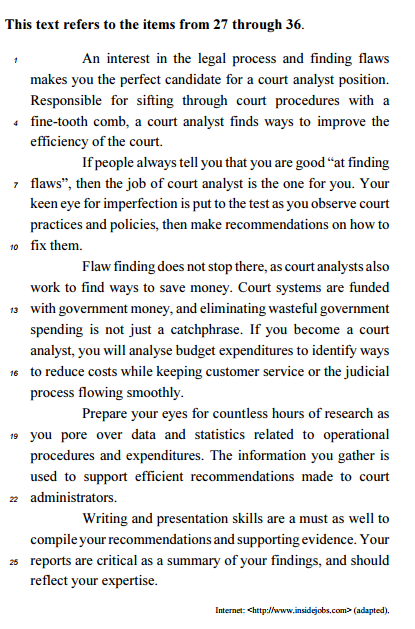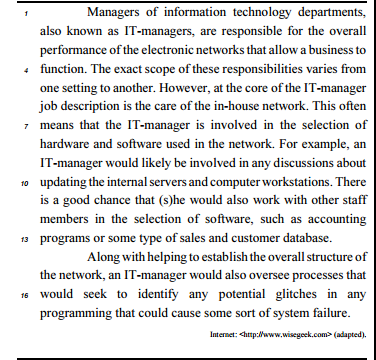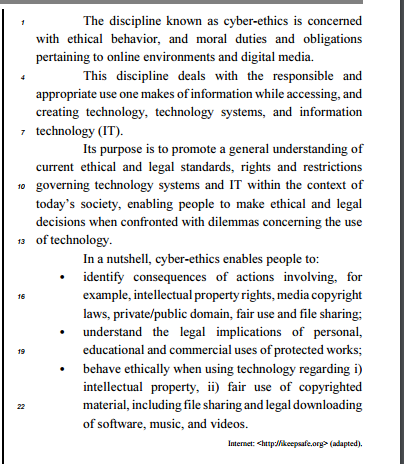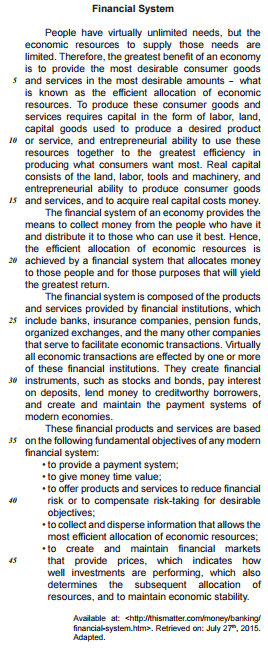
Judge the following items concerning the ideas and the language
used in the text above.
The text shows that the concept of technology can be much broader than one usually thinks.

Based on the text above, judge the following items.
In the text, “murals, concrete grain silos, an 800-year-old castle, and a plane” (L. 4 and 5) and “Times Square billboards” (L.6) are examples of sizeable spaces which are at the same level in terms of promoting the duo’s work.
TEXT 2
Innovation is the new key to survival
[…]
At its most basic, innovation presents an optimal strategy for
controlling costs. Companies that have invested in such technologies
as remote mining, autonomous equipment and driverless trucks and
trains have reduced expenses by orders of magnitude, while
simultaneously driving up productivity.
Yet, gazing towards the horizon, it is rapidly becoming clear that
innovation can do much more than reduce capital intensity.
Approached strategically, it also has the power to reduce people and
energy intensity, while increasing mining intensity.
Capturing the learnings
The key is to think of innovation as much more than research and
development (R&D) around particular processes or technologies.
Companies can, in fact, innovate in multiple ways, such as leveraging
supplier knowledge around specific operational challenges,
redefining their participation in the energy value chain or finding new
ways to engage and partner with major stakeholders and
constituencies.
To reap these rewards, however, mining companies must overcome
their traditionally conservative tendencies. In many cases, miners
struggle to adopt technologies proven to work at other mining
companies, let alone those from other industries. As a result,
innovation becomes less of a technology problem and more of an
adoption problem.
By breaking this mindset, mining companies can free themselves to
adapt practical applications that already exist in other industries and
apply them to fit their current needs. For instance, the tunnel boring
machines used by civil engineers to excavate the Chunnel can vastly
reduce miners' reliance on explosives. Until recently, those machines
were too large to apply in a mining setting. Some innovators,
however, are now incorporating the underlying technology to build
smaller machines—effectively adapting mature solutions from other
industries to realize more rapid results.
Re-imagining the future
At the same time, innovation mandates companies to think in
entirely new ways. Traditionally, for instance, miners have focused on
extracting higher grades and achieving faster throughput by
optimizing the pit, schedule, product mix and logistics. A truly
innovative mindset, however, will see them adopt an entirely new
design paradigm that leverages new information, mining and energy
technologies to maximize value. […]
Approached in this way, innovation can drive more than cost
reduction. It can help mining companies mitigate and manage risks,
strengthen business models and foster more effective community
and government relations. It can help mining services companies
enhance their value to the industry by developing new products and
services. Longer-term, it can even position organizations to move the
needle on such endemic issues as corporate social responsibility,
environmental performance and sustainability.
(http://www2.deloitte.com/content/dam/Deloitte/ru/Document
s/energy-resources/ru_er_tracking_the_trends_2015_eng.pdf)
The fragment “To reap these rewards” (l. 17) means to:
TEXT 3
Sustainable mining – oxymoron or a way of the future?
Mining is an activity that has persisted since the start of humans
using tools. However, one might argue that digging a big hole in
the ground and selling the finite resources that come out of that
hole is not sustainable, especially when the digging involves the
use of other finite resources (i.e. fuels) and produces a lot of
greenhouse gases.
The counter argument could go along the lines that minerals are
not being lost or destroyed through mining and mineral
processing – the elements are being shifted around, and
converted into new forms. Metals can even be extracted from
waste, seawater or even sewage, and recycled. But a more simple
argument is possible: a mine can be sustainable if it is
economically, socially and environmentally beneficial in the short
and long term. To be sustainable, the positive benefits of mining
should outweigh any negative impacts. […]
Social positives are often associated with mines in regional areas,
such as providing better amenities in a nearby town, or providing
employment (an economic and social positive). Social negatives
can also occur, such as dust, noise, traffic and visual amenity.
These are commonly debated and, whilst sometimes
controversial, can be managed with sufficient corporate
commitment, stakeholder engagement, and enough time to work
through the issues. Time is the key parameter - it may take
several years for a respectful process of community input, but as
long as it is possible for social negatives to be outweighed by
social positives, then the project will be socially sustainable.
It is most likely that a mine development will have some
environmental negatives, such as direct impacts on flora and
fauna through clearing of vegetation and habitat within the mine
footprint. Some mines will have impacts which extend beyond
the mine site, such as disruption to groundwater, production of
silt and disposal of waste. Certainly these impacts will need to be
managed throughout the mine life, along with robust
rehabilitation and closure planning. […]
The real turning point will come when mining companies go
beyond environmental compliance to create 'heritage projects'
that can enhance the environmental or social benefits in a
substantial way – by more than the environmental offsets
needed just to make up for the negatives created by the mine. In
order to foster these innovative mining heritage projects we need
to promote 'sustainability assessments' - not just 'environmental
assessments'. This will lead to a more mature appreciation of the
whole system whereby the economic and social factors, as well as
environmental factors, are considered in a holistic manner.
(adapted from https://www.engineersaustralia.org.au/westernaustralia-division/sustainable-mining-oxymoron-or-way-future.
Retrieved on August 10, 2015)
The excerpt “one might argue” (l.2) expresses:

According to the text, judge the following items.
The analyst ought to be a researcher.

Based on the text, judge the items below
A sound knowledge of English is highly important for technician positions.

According to the text, it can be correctly concluded that
technicians are expected to be able to keep up with new technologies.
From the sentence of the text “The financial system of an
economy provides the means to collect money from the
people who have it and distribute it to those who can use it
best" (lines 16-18), it can be inferred that people who
This text refers to the next two questions
Systems developers maintain, audit and improve
organisational support systems by working on the internal
operations of computers, using existing systems or incorporating
new technologies to meet particular needs, often as advised by a
systems analyst or architect. They test both hard and software
systems, and diagnose and resolve system faults.
Their role also covers writing diagnostic programs,
designing, and writing code for operating systems and software to
ensure efficiency. When required, they make recommendations for
future developments. Depending on the type of organisation,
developers can become either systems or applications specialists.
The work undertaken by systems developers is generally
of a highly complex and technical nature, and involves the
application of computer science and mathematics in an environment
which is constantly evolving due to technological advances and the
strategic direction of their organisation.
Internet: www.prospects.ac.uk> (adapted).
According to the text, the tasks of a systems developer include

According to the job description presented — IT-managers —,
judge the following item.
Working with other personnel in the selection of software is a possibility in the IT-managers’ career.

Judge the next items according to the text presented on cyber-ethics.
Cyber-ethics has the aim of giving people straightforward instructions about how to work with situations arising in online environments.
What is the second step to calculate the price of your final product or service?
The system programmer installs, customizes, andmaintains
the operating system, andalso installs or upgrades products that run
on the system.
The system programmer might be presented with the latest
version of the operating system to upgrade the existing systems.
Alternatively, the installation might be as simple as upgrading a
single program.
The system programmer must be skilled at debugging
problems with system software. These problems are often captured
in a copy of the computer's memory contents called a dump, which
the system produces in response to a failing software product, user
job, or transaction. Armed with a dump andspecialized debugging
tools, the system programmer can determine where the components
have failed. When the error has occurred in a software product, the
system programmer works directly with the software vendor's
support representatives to discover whether the problem's cause is
known andwhether a patch is available.
Internet:
According to the text, system programmers




